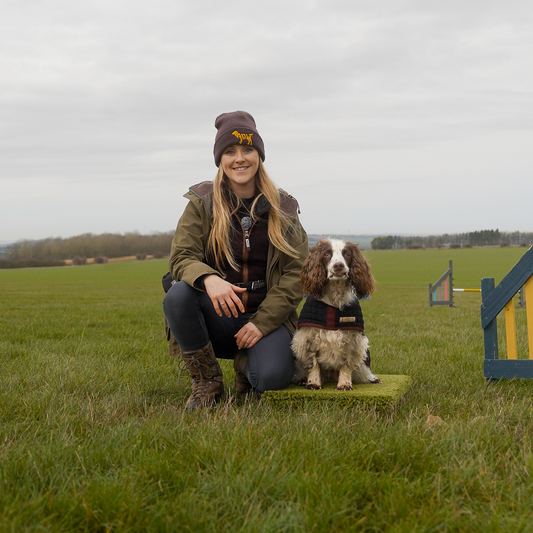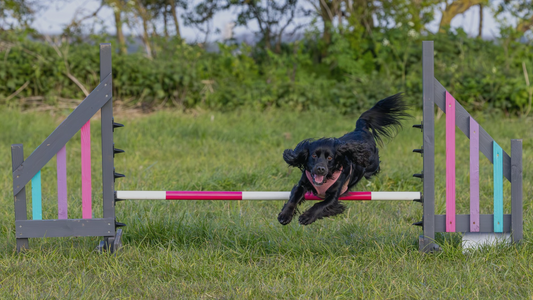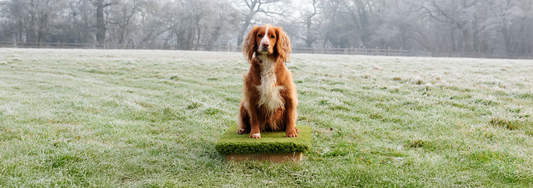How to stop dogs pulling. A Step-by-Step Guide
Loose lead walking can make a huge difference to your walks, turning them into a more enjoyable experience for both you and your dog. Whether you're in Balsham, Barton, or the surrounding areas of Cambridge, this guide is designed to help you train your dog to:
- Walk on a loose lead with no tension.
- Focus on you.
- Walk comfortably beside your leg.
Why Loose Lead Walking Matters
Dogs are natural body language readers. Without any formal training, dogs rely on body language as their primary method of communication. This means they are highly attuned to our movements. As soon as you start moving forward, dogs often take this as a cue of the direction we're headed and move off in that direction, pulling on the lead because they naturally walk faster than us.
To train your dog to walk calmly on a loose lead, it's essential to break the process down into achievable steps.
Setup:
- Treat pouch: Wear it on the side where you want your dog to walk.
- Lead positioning: Hold the lead with your opposite hand by your belly button, and be ready to feed your dog treats with the hand closest to them.
If you're unable to focus on these training goals every time you're out, use equipment to signal to your dog when different behaviours are expected. For example:
- Lead clipped to the back of a harness: Pulling is acceptable.
- Lead clipped to the front: You expect loose lead walking.
This clear distinction prevents confusion and ensures your training progress isn’t compromised.
Step 1: Building Eye Contact
Why start with eye contact? In dog training, eye contact is a "mutually exclusive behaviour," meaning a dog who’s looking at you cannot also be pulling ahead. By making eye contact with you, your dog is focusing on you rather than the environment around them, opening up a communication channel that’s key to loose lead walking.
How to train eye contact:
Here's a resource: https://angliandogworks.com/blogs/training-tips/eye-contact?_pos=2&_sid=f1f06cf83&_ss=r
Step 2: Teaching a Loose Lead
We support the dogs with our body language by turning into towards them and creating a connection.
Formula: step(s), say “good” and reward to their mouth.
Step-by-step guide to loose lead walking:
- Start by taking one step backward, say “good,” and reward your dog with a treat.
- Once your dog consistently follows this step, start to take additional steps backward before rewarding.
- Work up to 10 paces, then reward.
Repeat steps 1-3 but walk sideways instead.
If your dog starts sniffing or pulling at any point, it means we've made the training too hard, too quickly. Go back to taking just one step and rebuild the sequence from there.
Step 3: Walking Beside Your Leg
Now that your dog is learning to follow your lead, it's time to teach them to walk comfortably beside you.
If you've ever watched a dog play fetch, they start to hang out where they think the good stuff's going to drop?
Well, by consistently rewarding your dog at your side in line with your trouser seam, you can create a “reward hotspot” that encourages them to stay close.
Here’s how to train walking beside your leg:
Formula: step(s) forward, say “good” and reward.
- Take a step forward, say “good,” and drop your hand quickly to your trouser seam, delivering the treat right at your side.
- The quick movement of your hand draws your dog’s attention to the reward spot, teaching them that staying beside you is where the magic happens.
- Continue this up to 10 paces.
If at any point your dog starts to pull or sniff:
- Get their attention by calling their name.
- Walk backward (just like in Step 2) until the lead goes slack.
- Say “good,” reward, and start again.
The Power of Consistent Training
Loose lead walking doesn’t happen overnight, but the results are worth it. I always recommend focusing on quality, not quantity. A 20-minute training walk, where you focus on these steps, can be far more beneficial than a 20-minute loop around the block where your dog is pulling.
For the next 7 days, concentrate on rewarding the behaviours you want with treats your dog loves. Don’t worry about covering lots of ground—what matters most is reinforcing the right habits.
Work with a Professional Dog Trainer?
If you’re near Balsham, Barton, or Cambridge and need support with your dog’s loose lead walking or general behavior, I’d be happy to help through a 1-2-1 session.
Like the content we put out and want to stay updated and in the know?

Join our subscribers to gain short weekly emails (under 1-minute reads) plus the opportunity to reach out & get professional advice on your own training challenges. Read answers to members' FAQs, receive training & equipment news offers and tips directly to your inbox.
Click here to join our subscribers
About the author: Hi 👋 I’m Emma, accredited as a professional dog trainer by the Institute of Modern Dog Trainers (IMDT). I help owners of energetic dogs achieve the dog-owning life they envisioned by providing robust obedience & agility training for dogs across my two venues in Balsham and Barton, near Cambridge.
Disclaimer: The content of this article does not include personalised advice and is for information purposes only. If you need individual advice or other enquiries please click here to get in contact or if you're not local to Anglian Dog Works, you can find a trainer in your area by going to the IMDT website: https://www.imdt.uk.com/find-a-qualified-imdt-trainer






